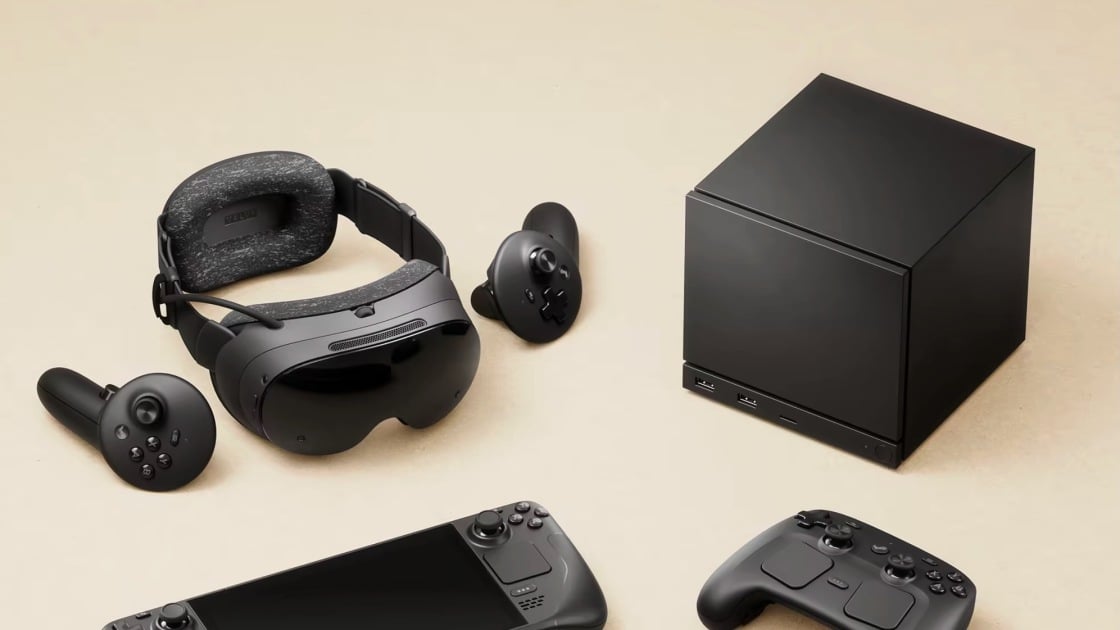Don’t miss out on our latest stories. Add PCMag as a preferred source on Google.
Valve is reviving the Steam Machine in a new mini PC that looks poised to rival game consoles.
The company today updated the Steam store to feature the upcoming product, alongside a new VR headset, the Steam Frame, and a redesigned Steam Controller. The Steam Machine has “over six times the horsepower” of the handheld Steam Deck, Valve says, meaning customers can expect a significant boost in frame rates and graphics.
The 5.7-pound Steam Machine is designed as a “powerful PC” packed into a 6-inch black cube. Although it can be placed on a desk, Valve also says it can be connected to a TV, enabling customers to play games from their Steam library on the big screen.

(Credit: Valve)
Like the Steam Deck, Valve’s mini PC runs on the Linux-based SteamOS, rather than Microsoft Windows. So, users won’t be getting a traditional PC. Nevertheless, Valve says the Steam Machine has been optimized to run PC games efficiently.
A big question is performance. IGN got some hands-on time with the Steam Machine and says it’s comparable to an Nvidia RTX 4060 or AMD RX 7600 mobile graphics card, making it more of a lower-end PC in terms of gaming. Meanwhile, Digital Foundry expects the Steam Machine’s performance to be between an Xbox Series S and a PlayStation 5, although closer to the PS5.

(Credit: Valve)
The machine itself uses a custom AMD chip that contains Zen 4 CPU with 6 cores for an up to 4.8GHz clock speed. For graphics, the chip harnesses an RDNA 3 GPU that features 28 compute units and 8GB GDDR6 video RAM.
Valve says the device can power 4K gaming at 60 frames per second while using AMD’s FidelityFX Super Resolution upscaling technology. The Steam Machine also comes with 16GB of DDR5 RAM, options for 512GB or 2TB of of NVMe SSD storage, and “a high-speed microSD card slot” for extra space.

Get Our Best Stories!
Your Daily Dose of Our Top Tech News
Thanks for signing up!
Your subscription has been confirmed. Keep an eye on your inbox!

(Credit: Valve)
The Steam Machine can connect to the internet via a Wi-Fi 6E modem or through an Ethernet port. The product also supports an HDMI port and a DisplayPort connection. The resulting product looks ready to disrupt the video game console market, especially when sales for Microsoft’s Xbox have lagged behind the PlayStation 5 and Nintendo Switch 2.
Steam Frame
On the VR front, Valve is preparing the Steam Frame, a follow-up to the Valve Index. It drops the tethered cables for a “streaming-first” experience that wirelessly beams the VR gaming from a PC to the headset. To enable the streaming, the headset comes with a “plug-and-play 6GHz wireless adapter” that operates over a USB dongle.

(Credit: Valve)
Another enhancement is how all the headset tracking occurs through a built-in camera system inside the hardware, ditching the need to place base station sensors around the user. The tracking relies on “four high-resolution, monochrome cameras” along with Infrared LEDs for use in dark environments.
Recommended by Our Editors
The company also upgraded the headset’s visuals. The Steam Frame supports a 2,160-by-2,160-pixel resolution for each eye that can run from 72 to 144Hz, an improvement from 1,600 by 1,440 resolution/120Hz in the Valve Index.

(Credit: Valve)
In addition, the Steam Frame can run games on its own as a standalone headset. It has a Snapdragon 8 Gen 3 processor, 16GB of LPDDR5X RAM, along with options for 256GB or 1GB of storage.
Valve adds that the one-pound Steam Frame “is lightweight and compact, with the weight balanced front-to-rear for a comfortable experience. It’s also easy to just slip on and play, with no wires and no setup.”
Both upcoming products can also pair with the redesigned Steam Controller, which the company says is the “ultimate customizable” accessory. It’s outfitted with “next-generation magnetic thumbsticks” that promise to avoid joy-con drift and reliability problems. Each controller also comes with a “puck” that can recharge the controller while also acting as a wireless transmitter.

(Credit: Valve)
Valve plans on releasing the new hardware sometime early next year. Pricing was not announced. Stay tuned for our coverage.
About Our Expert

Michael Kan
Senior Reporter
Experience
I’ve been a journalist for over 15 years. I got my start as a schools and cities reporter in Kansas City and joined PCMag in 2017, where I cover satellite internet services, cybersecurity, PC hardware, and more. I’m currently based in San Francisco, but previously spent over five years in China, covering the country’s technology sector.
Since 2020, I’ve covered the launch and explosive growth of SpaceX’s Starlink satellite internet service, writing 600+ stories on availability and feature launches, but also the regulatory battles over the expansion of satellite constellations, fights with rival providers like AST SpaceMobile and Amazon, and the effort to expand into satellite-based mobile service. I’ve combed through FCC filings for the latest news and driven to remote corners of California to test Starlink’s cellular service.
I also cover cyber threats, from ransomware gangs to the emergence of AI-based malware. Earlier this year, the FTC forced Avast to pay consumers $16.5 million for secretly harvesting and selling their personal information to third-party clients, as revealed in my joint investigation with Motherboard.
I also cover the PC graphics card market. Pandemic-era shortages led me to camp out in front of a Best Buy to get an RTX 3000. I’m now following how President Trump’s tariffs will affect the industry. I’m always eager to learn more, so please jump in the comments with feedback and send me tips.
This article was published by WTVG on 2025-11-12 15:16:00
View Original Post






